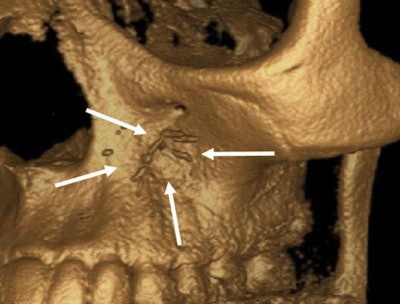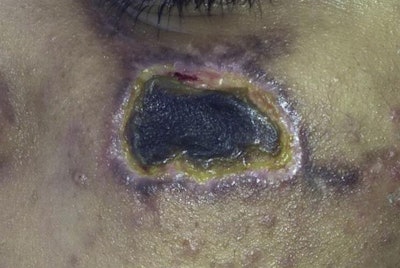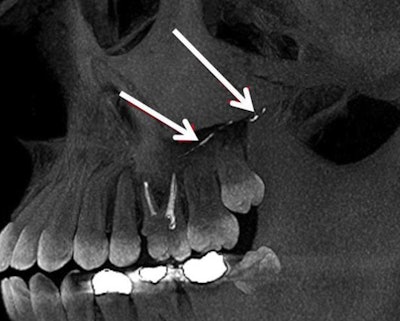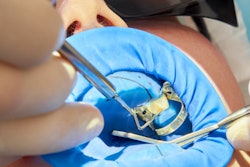
A substance often used to disinfect root canals was injected incorrectly and caused an unusual cutaneous reaction in a 16-year-old girl during endodontic treatment, according to a case report published on October 31 in the Journal of Endodontics.
Calcium hydroxide (CH), which has been used successfully for years but can cause serious damage if used incorrectly, was inadvertently injected beyond the girl's tooth apex during a root canal. This caused Nicolau syndrome, a rare cutaneous adverse reaction at the site of a drug injection, requiring her to undergo plastic surgery, the authors wrote.
"Careless handling of injectable CH can easily result in its displacement outside of the root canal system, which may increase the likelihood of the occurrence of Nicolau syndrome," wrote the group, led by Fatima Al-sheeb, an endodontic consultant at Hamad Dental Center in Doha, Qatar.
 A 3D reconstruction of a cone-beam computed tomography (CBCT) scan shows contrast material in the route of the infraorbital artery. All images courtesy of Al-sheeb et al. Licensed under CC BY 4.0.
A 3D reconstruction of a cone-beam computed tomography (CBCT) scan shows contrast material in the route of the infraorbital artery. All images courtesy of Al-sheeb et al. Licensed under CC BY 4.0.Calcium hydroxide has been used as a disinfectant in endodontic therapy for many years. The chemical also inhibits tooth resorption and induces repair by hard-tissue formation. However, its use comes with risks and complications, including accidental injection into surrounding vital structures, potentially causing thrombosis, skin necrosis, and connective tissue damage. This case is one of a limited number of reports of such adverse reactions, according to the authors.
The 16-year-old girl went for root canal treatment of tooth #14 at a dental clinic, the authors wrote. After preparation of her root canals, they began bleeding profusely. Due to her increasing pain, the dentist gave her local anesthesia. In an attempt to stop the bleeding, the canals were then injected with unset calcium hydroxide. The patient experienced severe pain and a change in skin color on her left cheek near her first permanent molar. She was prescribed antibiotics and analgesics.
The patient was referred to the maxillofacial surgery department at Hamad Dental Center. When she arrived at the department three days after the root canal treatment, she had swelling and a hematoma on the left cheek, paralysis on the left side of her lips, and excessive tearing from her left eye. Eventually, she developed a 4 x 4-cm necrotic patch of skin in the left infraorbital/molar region.
A plastic surgery appointment was scheduled to treat the necrotic area, and the girl was referred to the endodontic department to complete her root canal work, the authors wrote.
 The girl's skin when she arrived at the endodontic department at the dental center.
The girl's skin when she arrived at the endodontic department at the dental center.At the endodontic department, she underwent a clinical exam and imaging. A CBCT scan showed dislocation of opaque material from the canals of tooth #14 to the floor of the left maxillary sinus, posterior superior alveolar artery, infraorbital artery, and the area of the infraorbital foramen.
Clinicians determined that this material was likely the unset calcium hydroxide, and they diagnosed the patient with Nicolau syndrome because she immediately experienced pain after injection and developed skin discoloration and swelling, the authors wrote.
 A CBCT image shows opaque material in the root of the posterior superior alveolar artery.
A CBCT image shows opaque material in the root of the posterior superior alveolar artery.Over three visits, endodontists successfully completed the girl's root canal treatment. Corrective plastic surgery repaired her tissue damage. At a six-month follow-up visit, the patient's pain and soft-tissue problems were resolved.
The primary causes of calcium hydroxide extrusion into soft tissue are forced injection and overinstrumentation. These causes should be carefully avoided, particularly when combined with large amounts of bleeding from the root apex, the authors advised.
"Despite the rarity of Nicolau syndrome, it is important to highlight the toxic effect of CH when displaced beyond the apex," Al-sheeb and colleagues concluded.




















